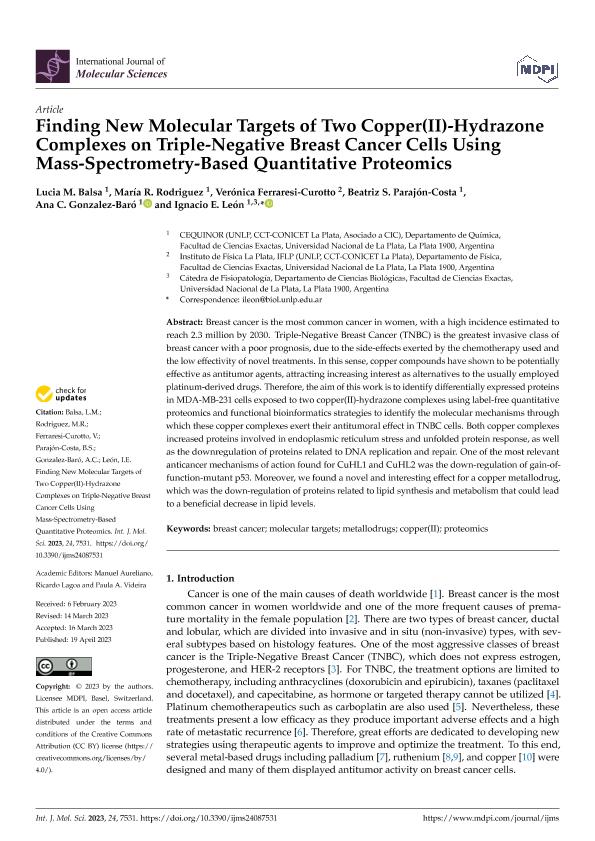Mostrar el registro sencillo del ítem
dc.contributor.author
Balsa, Lucia Mariana

dc.contributor.author
Rodríguez, María Rosa

dc.contributor.author
Ferraresi Curotto, Verónica

dc.contributor.author
Parajón Costa, Beatriz Susana

dc.contributor.author
Gonzalez Baro, Ana Cecilia

dc.contributor.author
Leon, Ignacio Esteban

dc.date.available
2024-02-16T15:18:05Z
dc.date.issued
2023-04
dc.identifier.citation
Balsa, Lucia Mariana; Rodríguez, María Rosa; Ferraresi Curotto, Verónica; Parajón Costa, Beatriz Susana; Gonzalez Baro, Ana Cecilia; et al.; Finding New Molecular Targets of Two Copper(II)-Hydrazone Complexes on Triple-Negative Breast Cancer Cells Using Mass-Spectrometry-Based Quantitative Proteomics; MDPI; International Journal of Molecular Sciences; 24; 8; 4-2023; 1-22
dc.identifier.issn
1661-6596
dc.identifier.uri
http://hdl.handle.net/11336/227281
dc.description.abstract
Breast cancer is the most common cancer in women, with a high incidence estimated to reach 2.3 million by 2030. Triple-Negative Breast Cancer (TNBC) is the greatest invasive class of breast cancer with a poor prognosis, due to the side-effects exerted by the chemotherapy used and the low effectivity of novel treatments. In this sense, copper compounds have shown to be potentially effective as antitumor agents, attracting increasing interest as alternatives to the usually employed platinum-derived drugs. Therefore, the aim of this work is to identify differentially expressed proteins in MDA-MB-231 cells exposed to two copper(II)-hydrazone complexes using label-free quantitative proteomics and functional bioinformatics strategies to identify the molecular mechanisms through which these copper complexes exert their antitumoral effect in TNBC cells. Both copper complexes increased proteins involved in endoplasmic reticulum stress and unfolded protein response, as well as the downregulation of proteins related to DNA replication and repair. One of the most relevant anticancer mechanisms of action found for CuHL1 and CuHL2 was the down-regulation of gain-of-function-mutant p53. Moreover, we found a novel and interesting effect for a copper metallodrug, which was the down-regulation of proteins related to lipid synthesis and metabolism that could lead to a beneficial decrease in lipid levels.
dc.format
application/pdf
dc.language.iso
eng
dc.publisher
MDPI
dc.rights
info:eu-repo/semantics/openAccess
dc.rights.uri
https://creativecommons.org/licenses/by/2.5/ar/
dc.subject
BREAST CANCER
dc.subject
COPPER(II)
dc.subject
METALLODRUGS
dc.subject
MOLECULAR TARGETS
dc.subject
PROTEOMICS
dc.subject.classification
Métodos de Investigación en Bioquímica

dc.subject.classification
Ciencias Biológicas

dc.subject.classification
CIENCIAS NATURALES Y EXACTAS

dc.title
Finding New Molecular Targets of Two Copper(II)-Hydrazone Complexes on Triple-Negative Breast Cancer Cells Using Mass-Spectrometry-Based Quantitative Proteomics
dc.type
info:eu-repo/semantics/article
dc.type
info:ar-repo/semantics/artículo
dc.type
info:eu-repo/semantics/publishedVersion
dc.date.updated
2024-02-14T15:56:02Z
dc.identifier.eissn
1422-0067
dc.journal.volume
24
dc.journal.number
8
dc.journal.pagination
1-22
dc.journal.pais
Suiza

dc.journal.ciudad
Basel
dc.description.fil
Fil: Balsa, Lucia Mariana. Consejo Nacional de Investigaciones Científicas y Técnicas. Centro Científico Tecnológico Conicet - La Plata. Centro de Química Inorgánica "Dr. Pedro J. Aymonino". Universidad Nacional de La Plata. Facultad de Ciencias Exactas. Centro de Química Inorgánica "Dr. Pedro J. Aymonino"; Argentina
dc.description.fil
Fil: Rodríguez, María Rosa. Consejo Nacional de Investigaciones Científicas y Técnicas. Centro Científico Tecnológico Conicet - La Plata. Centro de Química Inorgánica "Dr. Pedro J. Aymonino". Universidad Nacional de La Plata. Facultad de Ciencias Exactas. Centro de Química Inorgánica "Dr. Pedro J. Aymonino"; Argentina
dc.description.fil
Fil: Ferraresi Curotto, Verónica. Consejo Nacional de Investigaciones Científicas y Técnicas. Centro Científico Tecnológico Conicet - La Plata. Instituto de Física La Plata. Universidad Nacional de La Plata. Facultad de Ciencias Exactas. Instituto de Física La Plata; Argentina
dc.description.fil
Fil: Parajón Costa, Beatriz Susana. Consejo Nacional de Investigaciones Científicas y Técnicas. Centro Científico Tecnológico Conicet - La Plata. Centro de Química Inorgánica "Dr. Pedro J. Aymonino". Universidad Nacional de La Plata. Facultad de Ciencias Exactas. Centro de Química Inorgánica "Dr. Pedro J. Aymonino"; Argentina
dc.description.fil
Fil: Gonzalez Baro, Ana Cecilia. Consejo Nacional de Investigaciones Científicas y Técnicas. Centro Científico Tecnológico Conicet - La Plata. Centro de Química Inorgánica "Dr. Pedro J. Aymonino". Universidad Nacional de La Plata. Facultad de Ciencias Exactas. Centro de Química Inorgánica "Dr. Pedro J. Aymonino"; Argentina
dc.description.fil
Fil: Leon, Ignacio Esteban. Consejo Nacional de Investigaciones Científicas y Técnicas. Centro Científico Tecnológico Conicet - La Plata. Centro de Química Inorgánica "Dr. Pedro J. Aymonino". Universidad Nacional de La Plata. Facultad de Ciencias Exactas. Centro de Química Inorgánica "Dr. Pedro J. Aymonino"; Argentina
dc.journal.title
International Journal of Molecular Sciences
dc.relation.alternativeid
info:eu-repo/semantics/altIdentifier/url/https://www.mdpi.com/1422-0067/24/8/7531
dc.relation.alternativeid
info:eu-repo/semantics/altIdentifier/doi/http://dx.doi.org/10.3390/ijms24087531
Archivos asociados
